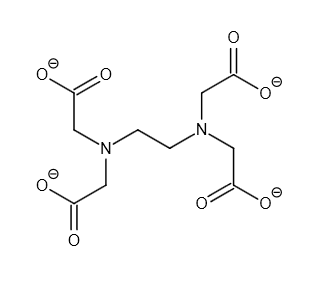
The total number of coordination sites in ethylenediaminetetraacetate () is_______.
Answer
220.2k+ views
Hint: The coordination number of an atom refers to the total number of atoms, ions, or molecules bonded to that atom in a certain molecule or crystal. The ligancy of an atom is frequently referred to as its coordination number. The ligands are the atoms, ions, or molecules bonded to the central atom (molecule/ion). The ligancy of molecules is computed differently when estimating the coordination number of a central atom in a crystal.
Complete Step by Step Solution:
\[{\left[ {C{H_2}N{{(C{H_2}C{O_2}H)}_2}} \right]_2}\] is the formula for the aminopolycarboxylic acid ethylenediaminetetraacetic acid (EDTA). two. Iron and calcium ions are typically bound with this water-soluble whitish material. As a hexadentate ("six-toothed") chelating agent, it binds these ions. Disodium EDTA, sodium calcium edetate, and tetrasodium EDTA are some of the different types of EDTA. In coordination chemistry, \[EDT{A^{4 - }}\] belongs to the aminopolycarboxylic acid family of ligands. In most cases, the two amines and four carboxylates in \[EDT{A^{4 - }}\] bind to a metal cation.

Image: Structure of \[EDT{A^{4 - }}\]
The \[EDT{A^{4 - }}\] coordination number is \[6\] . The number of ligand atoms directly linked to the core metal atom or ion via the coordinate bond is the metal's or ion's coordinate number. The number of chemical bonds produced between the ligand and the core metal atom or ion is the number of chemical bonds made between the ligand and the core metal atom or ion.
Note: Concerns about the biodegradability of aminopolycarboxylates such as EDTA have generated concern about environmental safety. As a result of these concerns, researchers are looking for alternative aminopolycarboxylates. Potential chelating agents include nitrilotriacetic acid (NTA), iminodisuccinic acid (IDS), polyaspartic acid, S,S-ethylenediamine-N,N′-disuccinic acid (EDDS), methylglycinediacetic acid (MGDA), and L-glutamic acid N,N-diacetic acid, tetrasodium salt (GLDA).
Complete Step by Step Solution:
\[{\left[ {C{H_2}N{{(C{H_2}C{O_2}H)}_2}} \right]_2}\] is the formula for the aminopolycarboxylic acid ethylenediaminetetraacetic acid (EDTA). two. Iron and calcium ions are typically bound with this water-soluble whitish material. As a hexadentate ("six-toothed") chelating agent, it binds these ions. Disodium EDTA, sodium calcium edetate, and tetrasodium EDTA are some of the different types of EDTA. In coordination chemistry, \[EDT{A^{4 - }}\] belongs to the aminopolycarboxylic acid family of ligands. In most cases, the two amines and four carboxylates in \[EDT{A^{4 - }}\] bind to a metal cation.

Image: Structure of \[EDT{A^{4 - }}\]
The \[EDT{A^{4 - }}\] coordination number is \[6\] . The number of ligand atoms directly linked to the core metal atom or ion via the coordinate bond is the metal's or ion's coordinate number. The number of chemical bonds produced between the ligand and the core metal atom or ion is the number of chemical bonds made between the ligand and the core metal atom or ion.
Note: Concerns about the biodegradability of aminopolycarboxylates such as EDTA have generated concern about environmental safety. As a result of these concerns, researchers are looking for alternative aminopolycarboxylates. Potential chelating agents include nitrilotriacetic acid (NTA), iminodisuccinic acid (IDS), polyaspartic acid, S,S-ethylenediamine-N,N′-disuccinic acid (EDDS), methylglycinediacetic acid (MGDA), and L-glutamic acid N,N-diacetic acid, tetrasodium salt (GLDA).
Recently Updated Pages
Electricity and Magnetism Explained: Key Concepts & Applications

JEE Energetics Important Concepts and Tips for Exam Preparation

JEE Isolation, Preparation and Properties of Non-metals Important Concepts and Tips for Exam Preparation

JEE Main 2021 July 25 Shift 1 Question Paper with Answer Key

JEE Main 2021 July 22 Shift 2 Question Paper with Answer Key

States of Matter Chapter For JEE Main Chemistry

Trending doubts
JEE Main 2026: Application Form Open, Exam Dates, Syllabus, Eligibility & Question Papers

Derivation of Equation of Trajectory Explained for Students

Hybridisation in Chemistry – Concept, Types & Applications

Understanding the Angle of Deviation in a Prism

Understanding Atomic Structure for Beginners

How to Convert a Galvanometer into an Ammeter or Voltmeter

Other Pages
Solutions Class 12 Chemistry Chapter 1 CBSE Notes - 2025-26

NCERT Solutions For Class 12 Chemistry Chapter 1 Solutions - 2025-26

The D and F Block Elements Class 12 Chemistry Chapter 4 CBSE Notes - 2025-26

NCERT Solutions for Class 12 Chemistry Chapter Chapter 7 Alcohol Phenol and Ether

NCERT Solutions ForClass 12 Chemistry Chapter Chapter 8 Aldehydes Ketones And Carboxylic Acids

JEE Advanced Marks vs Ranks 2025: Understanding Category-wise Qualifying Marks and Previous Year Cut-offs




